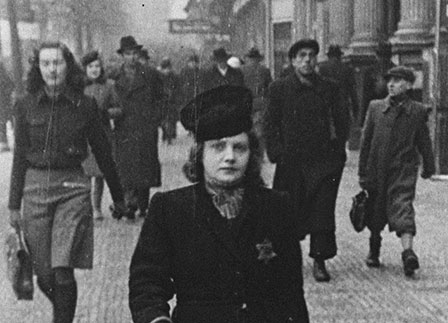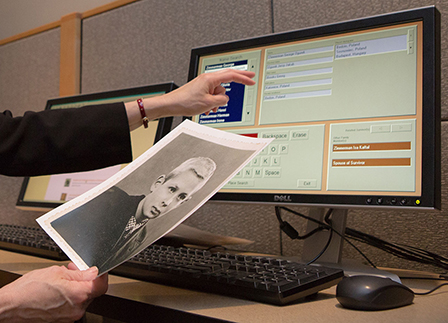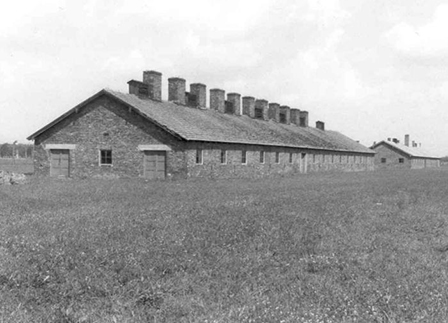Overview
- Brief Narrative
- 50 pfennig receipt issued in the Łódź ghetto in Poland in May 1940. Nazi Germany occupied Poland on September 1, 1939; Łódź was renamed Litzmannstadt and annexed to the German Reich. In February, the Germans forcibly relocated the large Jewish population into a sealed ghetto. All currency was confiscated in exchange for Quittungen [receipts] that could be exchanged only in the ghetto. The scrip was designed by the Judenrat [Jewish Council] and includes traditional Jewish symbols. The Germans closed the ghetto in the summer of 1944 by deporting the residents to concentration camps or killing centers.
- Date
-
issue:
1940 May 15
- Geography
-
issue:
Litzmannstadt-Getto (Łódź, Poland);
Łódź (Poland)
- Credit Line
- United States Holocaust Memorial Museum Collection, Gift of The 1990 Jewish Welfare Fund Appeal of Cleveland's Pre-Mission to Poland Group: Sheldon Green, Minda Jaffe, Sandra Lipman, Bonnie Marks, Tim Neustadt, Victoria Neustadt, Elmer Paull, Alan Schonberg, Carole Schonberg, Harry Steiger
- Markings
- face, upper right corner, outline in purple square : 50
face, center, black ink: QUITTUNG / ÜBER / 50 PFENNIG / DER AELTESTE DER JUDEN / IN LITZMANNSTADT / M. Rumkowski / LITZMANNSTADT , DEN 15 MAI 1940 [Receipt / for / 50 cents / The Eldest of the Jews / in Litzmannstadt / M. Rumkowski / Litzmannstadt 15 May 1940]
face, lower left corner, inside purple square : 50
back, upper left and right corner, outline in black ink : 50 50
back, top center, black ink: QUITTUNG ÜBER / FÜNFZIG PFENNIG [Receipt for / 50 cents]
back, serial number, lower center, orange ink : Nº 357445
back, lower center, black ink : WER DIESE QUITTUNG VERFÄLSCHT / ODER NACHMACHT ODER GEFÄLSCHTE / QUITTUNGEN IN VERKEHR BRINGT / WIRD STRENGSTENS BESTRAFT [ANYONE WHO FALSIFIES OR COPIES THIS RECEIPT, OR TRAFFICS IN COUNTERFEIT RECEIPTS, WILL BE STRICTLY PUNISHED] - Contributor
-
Issuer:
Der Aelteste der Juden in Litzmannstadt
Physical Details
- Language
- German
- Classification
-
Exchange Media
- Category
-
Money
- Object Type
-
Scrip (aat)
- Physical Description
- Łódź ghetto scrip printed on rectangular offwhite paper in green, purple, and black ink. The face has the denomination 50 in the lower left and upper right corners and a Star of David in the upper left and lower right corners. There is a rectangle of interlocked Magen David with a 7 branched menorah in the center over a latticework underprint. There is an overprint of the denomination 50 PFENNIG and German text in the center. The back has the denomination 50 in the top corners with FUNFZIG PFENNIG in the top center. The serial number and German text are in the bottom center. There is a background of interlocked Magen Davids. The scrip is soiled, very worn, and has creases and tears.
- Dimensions
- overall: Height: 2.125 inches (5.398 cm) | Width: 3.375 inches (8.573 cm)
- Materials
- g : paper
overall : ink
Rights & Restrictions
- Conditions on Access
- No restrictions on access
- Conditions on Use
- No restrictions on use
Keywords & Subjects
Administrative Notes
- Legal Status
- Permanent Collection
- Provenance
- The scrip was donated to the United States Holocaust Memorial Museum in 1990 by Sheldon Green, of the Jewish Community Federation of Cleveland.
- Funding Note
- The cataloging of this artifact has been supported by a grant from the Conference on Jewish Material Claims Against Germany.
- Record last modified:
- 2022-07-28 17:43:49
- This page:
- http://collections.ushmm.org/search/catalog/irn4079
Download & Licensing
In-Person Research
- By Appointment
- Request 21 Days in Advance of Visit
- Plan a Research Visit
- Request to See This Object
Contact Us
Also in The 1990 Jewish Welfare Fund Appeal of Cleveland's Pre-Mission to Poland Group collection
The collection consists of nine pieces of scrip from the Łódź (Litzmannstadt) ghetto in German occupied Poland scrip : nine 50 pfenning notes and ten 5 mark coins.
Date: approximately 1940-approximately 1943
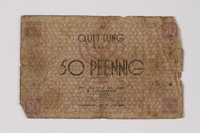
Łódź (Litzmannstadt) ghetto scrip, 50 pfennig note
Object
50 pfennig receipt issued in the Łódź ghetto in Poland in May 1940. Nazi Germany occupied Poland on September 1, 1939; Łódź was renamed Litzmannstadt and annexed to the German Reich. In February, the Germans forcibly relocated the large Jewish population into a sealed ghetto. All currency was confiscated in exchange for Quittungen [receipts] that could be exchanged only in the ghetto. The scrip was designed by the Judenrat [Jewish Council] and includes traditional Jewish symbols. The Germans closed the ghetto in the summer of 1944 by deporting the residents to concentration camps or killing centers.
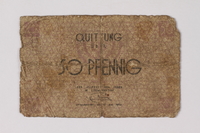
Łódź (Litzmannstadt) ghetto scrip, 50 pfennig note
Object
50 pfennig receipt issued in the Łódź ghetto in Poland in May 1940. Nazi Germany occupied Poland on September 1, 1939; Łódź was renamed Litzmannstadt and annexed to the German Reich. In February, the Germans forcibly relocated the large Jewish population into a sealed ghetto. All currency was confiscated in exchange for Quittungen [receipts] that could be exchanged only in the ghetto. The scrip was designed by the Judenrat [Jewish Council] and includes traditional Jewish symbols. The Germans closed the ghetto in the summer of 1944 by deporting the residents to concentration camps or killing centers.
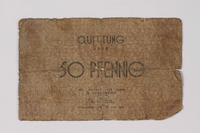
Łódź (Litzmannstadt) ghetto scrip, 50 pfennig note
Object
50 pfennig receipt issued in the Łódź ghetto in Poland in May 1940. Nazi Germany occupied Poland on September 1, 1939; Łódź was renamed Litzmannstadt and annexed to the German Reich. In February, the Germans forcibly relocated the large Jewish population into a sealed ghetto. All currency was confiscated in exchange for Quittungen [receipts] that could be exchanged only in the ghetto. The scrip was designed by the Judenrat [Jewish Council] and includes traditional Jewish symbols. The Germans closed the ghetto in the summer of 1944 by deporting the residents to concentration camps or killing centers.
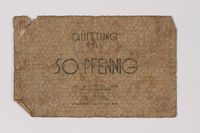
Łódź (Litzmannstadt) ghetto scrip, 50 pfennig note
Object
50 pfennig receipt issued in the Łódź ghetto in Poland in May 1940. Nazi Germany occupied Poland on September 1, 1939; Łódź was renamed Litzmannstadt and annexed to the German Reich. In February, the Germans forcibly relocated the large Jewish population into a sealed ghetto. All currency was confiscated in exchange for Quittungen [receipts] that could be exchanged only in the ghetto. The scrip was designed by the Judenrat [Jewish Council] and includes traditional Jewish symbols. The Germans closed the ghetto in the summer of 1944 by deporting the residents to concentration camps or killing centers.
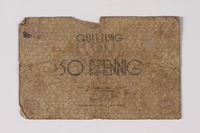
Łódź (Litzmannstadt) ghetto scrip, 50 pfennig note
Object
50 pfennig receipt issued in the Łódź ghetto in Poland in May 1940. Nazi Germany occupied Poland on September 1, 1939; Łódź was renamed Litzmannstadt and annexed to the German Reich. In February, the Germans forcibly relocated the large Jewish population into a sealed ghetto. All currency was confiscated in exchange for Quittungen [receipts] that could be exchanged only in the ghetto. The scrip was designed by the Judenrat [Jewish Council] and includes traditional Jewish symbols. The Germans closed the ghetto in the summer of 1944 by deporting the residents to concentration camps or killing centers.
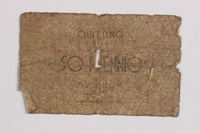
Łódź (Litzmannstadt) ghetto scrip, 50 pfennig note
Object
50 pfennig receipt issued in the Łódź ghetto in Poland in May 1940. Nazi Germany occupied Poland on September 1, 1939; Łódź was renamed Litzmannstadt and annexed to the German Reich. In February, the Germans forcibly relocated the large Jewish population into a sealed ghetto. All currency was confiscated in exchange for Quittungen [receipts] that could be exchanged only in the ghetto. The scrip was designed by the Judenrat [Jewish Council] and includes traditional Jewish symbols. The Germans closed the ghetto in the summer of 1944 by deporting the residents to concentration camps or killing centers.
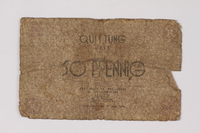
Łódź (Litzmannstadt) ghetto scrip, 50 pfennig note
Object
50 pfennig receipt issued in the Łódź ghetto in Poland in May 1940. Nazi Germany occupied Poland on September 1, 1939; Łódź was renamed Litzmannstadt and annexed to the German Reich. In February, the Germans forcibly relocated the large Jewish population into a sealed ghetto. All currency was confiscated in exchange for Quittungen [receipts] that could be exchanged only in the ghetto. The scrip was designed by the Judenrat [Jewish Council] and includes traditional Jewish symbols. The Germans closed the ghetto in the summer of 1944 by deporting the residents to concentration camps or killing centers.
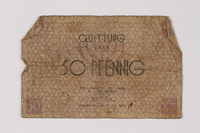
Łódź (Litzmannstadt) ghetto scrip, 50 pfennig note
Object
50 pfennig receipt issued in the Łódź ghetto in Poland in May 1940. Nazi Germany occupied Poland on September 1, 1939; Łódź was renamed Litzmannstadt and annexed to the German Reich. In February, the Germans forcibly relocated the large Jewish population into a sealed ghetto. All currency was confiscated in exchange for Quittungen [receipts] that could be exchanged only in the ghetto. The scrip was designed by the Judenrat [Jewish Council] and includes traditional Jewish symbols. The Germans closed the ghetto in the summer of 1944 by deporting the residents to concentration camps or killing centers.
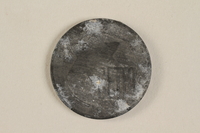
Łódź (Litzmannstadt) ghetto scrip, 5 mark coin
Object
5 mark coin issued in the Łódź ghetto in Poland in 1943. Nazi Germany occupied Poland on September 1, 1940; Łódź was renamed Litzmannstadt and annexed to the German Reich. In February, the Germans forcibly relocated the large Jewish population into a sealed ghetto. All currency was confiscated in exchange for Quittungen [receipts] that could be exchanged only in the ghetto. The scrip and tokens were designed by the Judenrat [Jewish Council] and includes traditional Jewish symbols. The Germans closed the ghetto in the summer of 1944 by deporting the residents to concentration camps or killing centers.
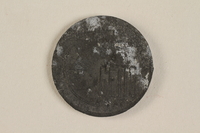
Łódź (Litzmannstadt) ghetto scrip, 5 mark coin
Object
5 mark coin issued in the Łódź ghetto in Poland in 1943. Nazi Germany occupied Poland on September 1, 1940; Łódź was renamed Litzmannstadt and annexed to the German Reich. In February, the Germans forcibly relocated the large Jewish population into a sealed ghetto. All currency was confiscated in exchange for Quittungen [receipts] that could be exchanged only in the ghetto. The scrip and tokens were designed by the Judenrat [Jewish Council] and includes traditional Jewish symbols. The Germans closed the ghetto in the summer of 1944 by deporting the residents to concentration camps or killing centers.
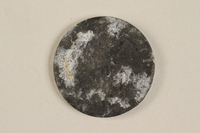
Łódź (Litzmannstadt) ghetto scrip, 5 mark coin
Object
5 mark coin issued in the Łódź ghetto in Poland in 1943. Nazi Germany occupied Poland on September 1, 1940; Łódź was renamed Litzmannstadt and annexed to the German Reich. In February, the Germans forcibly relocated the large Jewish population into a sealed ghetto. All currency was confiscated in exchange for Quittungen [receipts] that could be exchanged only in the ghetto. The scrip and tokens were designed by the Judenrat [Jewish Council] and includes traditional Jewish symbols. The Germans closed the ghetto in the summer of 1944 by deporting the residents to concentration camps or killing centers.
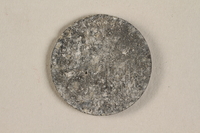
Łódź (Litzmannstadt) ghetto scrip, 5 mark coin
Object
5 mark coin issued in the Łódź ghetto in Poland in 1943. Nazi Germany occupied Poland on September 1, 1940; Łódź was renamed Litzmannstadt and annexed to the German Reich. In February, the Germans forcibly relocated the large Jewish population into a sealed ghetto. All currency was confiscated in exchange for Quittungen [receipts] that could be exchanged only in the ghetto. The scrip and tokens were designed by the Judenrat [Jewish Council] and includes traditional Jewish symbols. The Germans closed the ghetto in the summer of 1944 by deporting the residents to concentration camps or killing centers.
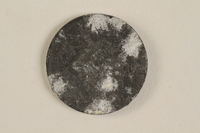
Łódź (Litzmannstadt) ghetto scrip, 5 mark coin
Object
5 mark coin issued in the Łódź ghetto in Poland in 1943. Nazi Germany occupied Poland on September 1, 1940; Łódź was renamed Litzmannstadt and annexed to the German Reich. In February, the Germans forcibly relocated the large Jewish population into a sealed ghetto. All currency was confiscated in exchange for Quittungen [receipts] that could be exchanged only in the ghetto. The scrip and tokens were designed by the Judenrat [Jewish Council] and includes traditional Jewish symbols. The Germans closed the ghetto in the summer of 1944 by deporting the residents to concentration camps or killing centers.
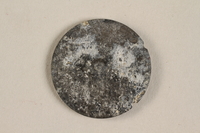
Łódź (Litzmannstadt) ghetto scrip, 5 mark coin
Object
5 mark coin issued in the Łódź ghetto in Poland in 1943. Nazi Germany occupied Poland on September 1, 1940; Łódź was renamed Litzmannstadt and annexed to the German Reich. In February, the Germans forcibly relocated the large Jewish population into a sealed ghetto. All currency was confiscated in exchange for Quittungen [receipts] that could be exchanged only in the ghetto. The scrip and tokens were designed by the Judenrat [Jewish Council] and includes traditional Jewish symbols. The Germans closed the ghetto in the summer of 1944 by deporting the residents to concentration camps or killing centers.
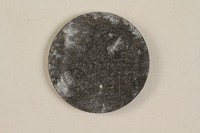
Łódź (Litzmannstadt) ghetto scrip, 5 mark coin
Object
5 mark coin issued in the Łódź ghetto in Poland in 1943. Nazi Germany occupied Poland on September 1, 1940; Łódź was renamed Litzmannstadt and annexed to the German Reich. In February, the Germans forcibly relocated the large Jewish population into a sealed ghetto. All currency was confiscated in exchange for Quittungen [receipts] that could be exchanged only in the ghetto. The scrip and tokens were designed by the Judenrat [Jewish Council] and includes traditional Jewish symbols. The Germans closed the ghetto in the summer of 1944 by deporting the residents to concentration camps or killing centers.
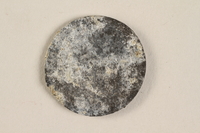
Łódź (Litzmannstadt) ghetto scrip, 5 mark coin
Object
5 mark coin issued in the Łódź ghetto in Poland in 1943. Nazi Germany occupied Poland on September 1, 1940; Łódź was renamed Litzmannstadt and annexed to the German Reich. In February, the Germans forcibly relocated the large Jewish population into a sealed ghetto. All currency was confiscated in exchange for Quittungen [receipts] that could be exchanged only in the ghetto. The scrip and tokens were designed by the Judenrat [Jewish Council] and includes traditional Jewish symbols. The Germans closed the ghetto in the summer of 1944 by deporting the residents to concentration camps or killing centers.
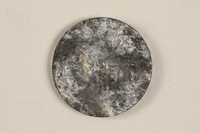
Łódź (Litzmannstadt) ghetto scrip, 5 mark coin
Object
5 mark coin issued in the Łódź ghetto in Poland in 1943. Nazi Germany occupied Poland on September 1, 1940; Łódź was renamed Litzmannstadt and annexed to the German Reich. In February, the Germans forcibly relocated the large Jewish population into a sealed ghetto. All currency was confiscated in exchange for Quittungen [receipts] that could be exchanged only in the ghetto. The scrip and tokens were designed by the Judenrat [Jewish Council] and includes traditional Jewish symbols. The Germans closed the ghetto in the summer of 1944 by deporting the residents to concentration camps or killing centers.
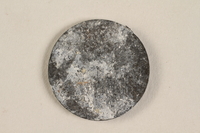
Łódź (Litzmannstadt) ghetto scrip, 5 mark coin
Object
5 mark coin issued in the Łódź ghetto in Poland in 1943. Nazi Germany occupied Poland on September 1, 1940; Łódź was renamed Litzmannstadt and annexed to the German Reich. In February, the Germans forcibly relocated the large Jewish population into a sealed ghetto. All currency was confiscated in exchange for Quittungen [receipts] that could be exchanged only in the ghetto. The scrip and tokens were designed by the Judenrat [Jewish Council] and includes traditional Jewish symbols. The Germans closed the ghetto in the summer of 1944 by deporting the residents to concentration camps or killing centers.

